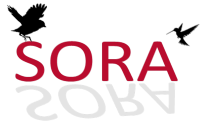Hummingbird Flower Lists
Hummingbird Flower Lists
That birds play an important part in the crossfertilization of flowers is now an established fact of science. A hummingbird with its ability to poise and hold a definite position on the wing is a more exact pollinator than is the short-winged, clumsy tumbling honey bee, and it can evidently do more with less pollen. But these birds are not indiscriminate in their flower choices. Do they prefer red flowers as some have thought? Or does the color of the gorget affect their taste for color in flowers? If so, why do they visit yellow and orange flowers when these colors are so strikingly absent from the plumage of the average hummer?
Some flowers like hen-and-chickens (Dudleya ovatifolia) are beak-tip pollinators, some like tree tobacco are beak-base pollinators, a few like larkspur use the throat, and some the forehead and crown, while one or two dust the back of the head or possibly the nape.
We may also divide bird flowers in general into four groups: 1. Flowers wholly pollinated by birds. 2. Flowers pollinated by birds with insect aid. 3. Flowers pollinated by insects with bird aid. 4. Flowers visited for nectar or insects without reciprocal aid.
I would greatly appreciate lists of garden and wild flowers which readers of the Condor have seen visited by birds of any species. Give where possible the scientific name of the flower, but if without technical knowledge of botany, send a pressed example of the flower, unless, as will now and then occur, the familiar name of a plant is restricted enough to warrant accuracy.
A. L. Pickens
Room 216, Zoology Building, University of California, Berkeley, California, July 19, 1929

